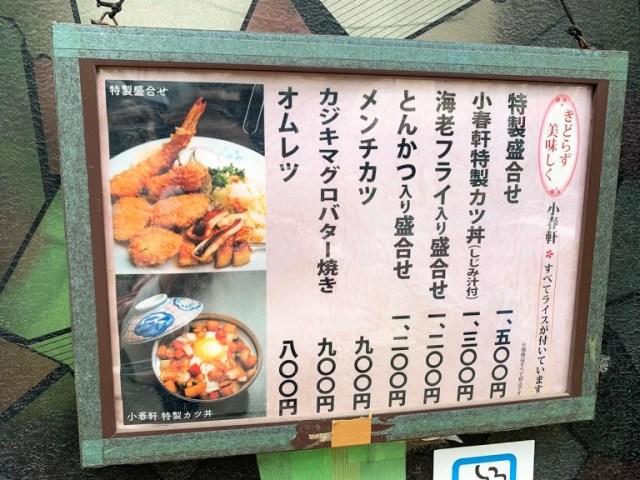
The Kojima family’s pork cutlet bowl recipe is both startlingly innovative and really, really old.
In a standard katsudon, or pork cutlet bowl, the cutlet is wrapped in omelet-like egg, for a tender, moist mouthfeel. Recently, though, there’s been a bit of a schism among katsudon fans in Japan, with some preferring the upstart style known as tojinai (“unbound”) katsudon, in which the meat and omelet are kept separate, resulting in a crispier texture when biting into the cutlet.
But on a recent stroll through Tokyo’s Ningyocho neighborhood, we came across an even more innovative style of katsudon…only to find out it actually predates the tojinai katsudon by more than a century.
Koharuken is a small, unassuming restaurant just a block away from Ningyocho Station. Their menu board has the typically tempting list of katsu specialty restaurant items, but in the bottom left corner is a photo of the “Koharuken Special Katsudon,” and it doesn’t look like a katsudon you’ll find anywhere else in Japan.
Traditionally, katsudon consists of a pork cutlet, egg, and rice. Maybe you might have some small shreds of onion mixed in with the egg, or some shredded cabbage if it’s an eggless katsudon with sauce. But the Koharuken Special Katsudon’s photo shows it topped with a variety of cubed vegetables, a katsudon topping we’d never seen before.
So, naturally, we had to try it.
At 1,300 yen (US$9.90), which also gets you a side of miso soup with clams, it’s an affordable edible adventure, especially considering that Ningyocho is one of the more expensive parts of downtown Tokyo. It wasn’t until we had our Koharuken Special Katsudon in front of us that we realized it also splits the difference between the wrapped-in-egg katsu and the tojinai type by using a soft boiled egg, which you can eat by itself or break up to cover the rest of the bowl’s ingredients.
But like we mentioned above, while this was an unprecedented eating experience for us, the Koharuken Special Katsudon has been around for a long time…but with a catch. Koharuken was opened all the way back in 1912, when Japan was still in the Meiji period, by a man named Tanesaburo Kojima. Tanesaburo came up with the idea of adding cubed carrot, onion, green pepper, and potato to his restaurant’s katsudon, but eventually, for reasons lost to antiquity, Koharuken’s unique take on the dish disappeared from the menu.
The Kojima family still runs the restaurant today, and when the fourth-generation owner, Yuji, took over in 1995, he decided he wanted to bring his great-grandfather’s version of katsudon back to the menu. There was only one problem: Yuji had never eaten the dish, and had only heard stories of it. Thankfully, there was one person still around who did have first-hand experience the dish, Yuji’s father, Mikio, who had eaten it as a boy when Tanesaburo, his grandfather, cooked it for him.
Based on Mikio’s childhood memories, Yuji was able to bring back the Koharuken Special Katsudon, and now it’s the most popular item on the restaurant’s menu.
The Koharuken Special Katsudon falls into the “sauce katsudon” sub-category, with the bite-sized pieces of meat treated with a sweet sauce with some spicy/salty notes to excite a wide range of your taste receptors. Breaking up the soft-boiled egg’s yolk adds a rich, creamy element too.
But of course, what really steals the show are the veggies. After being chopped, they’re stewed in demi-glace sauce, so they’re tender and flavorful.
Having eaten more katsudon than we can count in our lives, it took a few moments for our minds to wrap themselves around the concept of having so many vegetables with our pork cutlet bowl, the potatoes in particular, since they’re not so commonly used in traditional Japanese cooking (curry rice and nikujaga notwithstanding). But after two or three bites, any weirdness we were feeling was replaced by bliss at the straightforward deliciousness, and we’re happy this is one new-to-most-people recipe from over a hundred years ago that the Kojima family was able to bring back.
Restaurant information
Koharuken / 小春軒
Address: Tokyo-to, Chuo-ku, Nihonbashi Ningyocho 1-7-9
東京都中央区日本橋人形町1-7-9
Open 11 a.m.-1:45 p.m., 5 p.m.-7:45 p.m. (weekdays), 11 a.m.-1:45 p.m. (Saturdays)
Closed Sundays and holidays
Reference: Ryori Okoku, Machi Nihonbashi
Photos ©SoraNews24
● Want to hear about SoraNews24’s latest articles as soon as they’re published? Follow us on Facebook and Twitter!
[ Read in Japanese ]









 Katsudon for breakfast? Japan’s new bacon egg cutlet bowl may be the only meal we need all day
Katsudon for breakfast? Japan’s new bacon egg cutlet bowl may be the only meal we need all day How to make an imitation katsudon pork cutlet bowl using imitation katsu【SoraKitchen】
How to make an imitation katsudon pork cutlet bowl using imitation katsu【SoraKitchen】 Bacon and Egg Sauce Katsudon: A new way to eat breakfast in Japan
Bacon and Egg Sauce Katsudon: A new way to eat breakfast in Japan Katsudon vs. tonkatsu vs. katsu sandwich – What’s the best way to eat pork cutlet in Japan?
Katsudon vs. tonkatsu vs. katsu sandwich – What’s the best way to eat pork cutlet in Japan? Japan’s favorite pork cutlet sandwich maker also has awesome katsudon restaurant in Tokyo Station
Japan’s favorite pork cutlet sandwich maker also has awesome katsudon restaurant in Tokyo Station Foreigner’s request for help in Tokyo makes us sad for the state of society
Foreigner’s request for help in Tokyo makes us sad for the state of society Harajuku Station’s beautiful old wooden building is set to return, with a new complex around it
Harajuku Station’s beautiful old wooden building is set to return, with a new complex around it Red light district sushi restaurant in Tokyo shows us just how wrong we were about it
Red light district sushi restaurant in Tokyo shows us just how wrong we were about it Japan’s massive matcha parfait weighs 6 kilos, contains hidden surprises for anyone who eats it
Japan’s massive matcha parfait weighs 6 kilos, contains hidden surprises for anyone who eats it Ghibli Park now selling “Grilled Frogs” from food cart in Valley of Witches
Ghibli Park now selling “Grilled Frogs” from food cart in Valley of Witches Japanese city loses residents’ personal data, which was on paper being transported on a windy day
Japanese city loses residents’ personal data, which was on paper being transported on a windy day Japanese ramen restaurants under pressure from new yen banknotes
Japanese ramen restaurants under pressure from new yen banknotes Celebrate another year of life by putting it in jeopardy with this birthday candle flower
Celebrate another year of life by putting it in jeopardy with this birthday candle flower A Gintama fan’s emotional 19-year journey to buy a proper Lake Toya bokuto wooden katana【Pics】
A Gintama fan’s emotional 19-year journey to buy a proper Lake Toya bokuto wooden katana【Pics】 Anime girl English teacher Ellen-sensei becomes VTuber/VVTUber and NFT
Anime girl English teacher Ellen-sensei becomes VTuber/VVTUber and NFT McDonald’s new Happy Meals offer up cute and practical Sanrio lifestyle goods
McDonald’s new Happy Meals offer up cute and practical Sanrio lifestyle goods All-you-can-drink Starbucks and amazing views part of Tokyo’s new 170 meter-high sky lounge
All-you-can-drink Starbucks and amazing views part of Tokyo’s new 170 meter-high sky lounge French Fries Bread in Tokyo’s Shibuya becomes a hit on social media
French Fries Bread in Tokyo’s Shibuya becomes a hit on social media Studio Ghibli releases new action figures featuring Nausicaä of the Valley of the Wind characters
Studio Ghibli releases new action figures featuring Nausicaä of the Valley of the Wind characters New private rooms on Tokaido Shinkansen change the way we travel from Tokyo to Kyoto
New private rooms on Tokaido Shinkansen change the way we travel from Tokyo to Kyoto Studio Ghibli glasses cases let anime characters keep an eye on your spectacles
Studio Ghibli glasses cases let anime characters keep an eye on your spectacles Tokyo Tsukiji fish market site to be redeveloped with 50,000-seat stadium, hotel, shopping center
Tokyo Tsukiji fish market site to be redeveloped with 50,000-seat stadium, hotel, shopping center Beautiful Ghibli sealing wax kits let you create accessories and elegant letter decorations【Pics】
Beautiful Ghibli sealing wax kits let you create accessories and elegant letter decorations【Pics】 Studio Ghibli releases Kiki’s Delivery Service chocolate cake pouches in Japan
Studio Ghibli releases Kiki’s Delivery Service chocolate cake pouches in Japan New definition of “Japanese whiskey” goes into effect to prevent fakes from fooling overseas buyers
New definition of “Japanese whiskey” goes into effect to prevent fakes from fooling overseas buyers Our Japanese reporter visits Costco in the U.S., finds super American and very Japanese things
Our Japanese reporter visits Costco in the U.S., finds super American and very Japanese things Studio Ghibli unveils Mother’s Day gift set that captures the love in My Neighbour Totoro
Studio Ghibli unveils Mother’s Day gift set that captures the love in My Neighbour Totoro New Japanese KitKat flavour stars Sanrio characters, including Hello Kitty
New Japanese KitKat flavour stars Sanrio characters, including Hello Kitty More foreign tourists than ever before in history visited Japan last month
More foreign tourists than ever before in history visited Japan last month New Pokémon cakes let you eat your way through Pikachu and all the Eevee evolutions
New Pokémon cakes let you eat your way through Pikachu and all the Eevee evolutions Sales of Japan’s most convenient train ticket/shopping payment cards suspended indefinitely
Sales of Japan’s most convenient train ticket/shopping payment cards suspended indefinitely Sold-out Studio Ghibli desktop humidifiers are back so Totoro can help you through the dry season
Sold-out Studio Ghibli desktop humidifiers are back so Totoro can help you through the dry season Japanese government to make first change to romanization spelling rules since the 1950s
Japanese government to make first change to romanization spelling rules since the 1950s Ghibli founders Toshio Suzuki and Hayao Miyazaki contribute to Japanese whisky Totoro label design
Ghibli founders Toshio Suzuki and Hayao Miyazaki contribute to Japanese whisky Totoro label design Doraemon found buried at sea as scene from 1993 anime becomes real life【Photos】
Doraemon found buried at sea as scene from 1993 anime becomes real life【Photos】 Tokyo’s most famous Starbucks is closed
Tokyo’s most famous Starbucks is closed One Piece characters’ nationalities revealed, but fans have mixed opinions
One Piece characters’ nationalities revealed, but fans have mixed opinions We asked a Uniqlo employee what four things we should buy and their suggestions didn’t disappoint
We asked a Uniqlo employee what four things we should buy and their suggestions didn’t disappoint Princesses, fruits, and blacksmiths: Study reveals the 30 most unusual family names in Japan
Princesses, fruits, and blacksmiths: Study reveals the 30 most unusual family names in Japan Japanese restaurant chain shows us how to make katsudon in three minutes【SoraKitchen】
Japanese restaurant chain shows us how to make katsudon in three minutes【SoraKitchen】 Salmon katsudon? Tokyo restaurant’s specialty is like a deep-fried sashimi lunch【Photos】
Salmon katsudon? Tokyo restaurant’s specialty is like a deep-fried sashimi lunch【Photos】 How to turn McDonald’s chicken nuggets into tasty katsudon in five minutes【SoraKitchen】
How to turn McDonald’s chicken nuggets into tasty katsudon in five minutes【SoraKitchen】 Instant katsu? Taste-testing the tempting promise of freeze-dried tonkatsu topping【Taste test】
Instant katsu? Taste-testing the tempting promise of freeze-dried tonkatsu topping【Taste test】 Restaurant Yoshibei is crazy in the best way: A pork cutlet set with a side of pork cutlet bowl
Restaurant Yoshibei is crazy in the best way: A pork cutlet set with a side of pork cutlet bowl Tonkotsu ramen rice bowl blows our minds, makes us appreciate noodles in a new light
Tonkotsu ramen rice bowl blows our minds, makes us appreciate noodles in a new light We eat a meal to remember…at a Japanese police station in Fukuoka
We eat a meal to remember…at a Japanese police station in Fukuoka McKatsudon: Easy to make with new spicy chicken nuggets from McDonald’s Japan
McKatsudon: Easy to make with new spicy chicken nuggets from McDonald’s Japan All-plant-based katsu curry arrives at Ikea Japan
All-plant-based katsu curry arrives at Ikea Japan Tokyo’s Curry Udon Croquette Burger is four of Japan’s favorite foods in one【Taste test】
Tokyo’s Curry Udon Croquette Burger is four of Japan’s favorite foods in one【Taste test】 This Tempura Soba Burger has some famous credentials behind its creation
This Tempura Soba Burger has some famous credentials behind its creation 2021’s top stories in Japanese food and cooking news【SoraNews24 Year in Review】
2021’s top stories in Japanese food and cooking news【SoraNews24 Year in Review】 Our reporter investigates the strangely named “shaved ice donburi” at a Tokyo cafe
Our reporter investigates the strangely named “shaved ice donburi” at a Tokyo cafe Where to buy a Curry Bread Grand Prix 2023 award-winning karepan in Japan
Where to buy a Curry Bread Grand Prix 2023 award-winning karepan in Japan “Hey, Japanese taxi driver, take us to the best Okinawan restaurant in Naha!”
“Hey, Japanese taxi driver, take us to the best Okinawan restaurant in Naha!” This is Japan’s oldest oyakodon chicken-and-egg rice bowl restaurant, and it’s awesome
This is Japan’s oldest oyakodon chicken-and-egg rice bowl restaurant, and it’s awesome
Leave a Reply